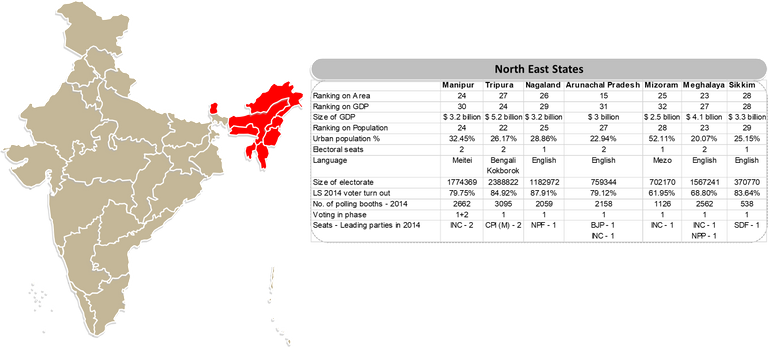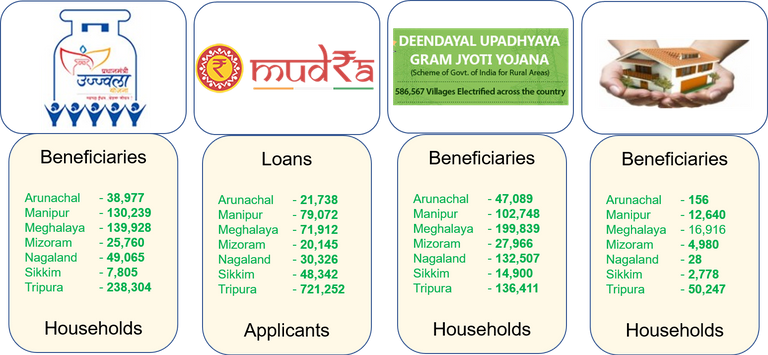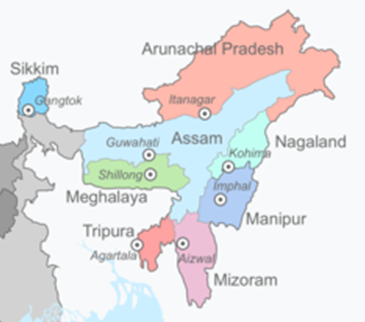We are starting a series of articles on the ‘General Elections’ in India that will elect the government for next five year term. The current term comes to an end in beginning June. A few days back we had published an overview article on the General Elections which is available in the blog – Race to 272. It explains the complete backdrop and how the electoral system works in India. Starting with this article we intend to bring out a series of about 12 articles that will present an in depth coverage of the elections, the issues involved and the seat projection for ruling party. Enjoy the articles and do upvote the same if you like them.

The picture below gives you the geographical location of the state on the Map of India. It also gives an overview of the state in terms of macro-level economic, political and electoral data.

India's northeast part consists of seven states commonly referred to as ‘Seven Sisters'. These states are Manipur, Tripura, Nagaland, Mizoram, Meghalaya, Sikkim, and Arunachal Pradesh. These states have so far never really come into mainstream politics in any meaningful way.
However, all that changed when the Modi government took oath in 2014. Right from day one, Modi declared that development of the neglected northeast states of India will be the topmost priority of his government. These were not mere empty words. The government appointed General V K Singh as Minister in charge of development of North East and provided a handsome budget for undertaking the various development projects. Many of the projects that were initiated many many years back and were lying unfinished were completed and dedicated to public service. The government also upped the ante by getting senior cabinet ministers to visit the region and give a push for its development. Air and road connectivity has been improved by an order of magnitude. The region has also been identified for ‘inland waterway routes' and some of them have started to operate also. As a result of all this, BJP has made strong inroads into the region in a big way since 2014. Hitherto, the states were either ruled by Congress or by regional parties. The biggest upset of them all was the routing of the CPI (M) government from Tripura in March 2018 by BJP. A government that had been in power for more than two decades were overthrown by 2/3rd majority by the BJP government. Some other states are also under the rule of BJP allies in NDA. The efforts on development front by BJP are getting strong support with the native population at ground level because of the fact that the literacy rate in the entire North East states is very good – 70% plus. This gives them an aspirational outlook on Lok Sabha elections.
There is however one very significant development that has taken place in January 2019. The government of India has brought a ‘Citizenship Amendment Bill’ (CAB) and has passed it through the lower house i.e. Lok Sabha. The bill, however, has to pass through Rajya Sabha before becoming a law. As per this bill minority communities fleeing religious persecution from surrounding countries like Bangladesh, Pakistan, and Afghanistan, etc. will be granted Indian citizenship. All these countries are Muslim majority countries and minorities there would include – Hindus, Sikhs, Buddhists, Jains, Parsis, and Christians. The bill is being opposed by almost all states across North East as they are likely to face the brunt of resettlement of these people and feel that there own identities may get lost over time. It has therefore not gone down too well. There is thus a toss up and balancing of this negative with the extreme huge positive of development benefits.

Dynamics at play in each of the seven states

1. Manipur
Manipur politics has been dominated by the Congress party since long. Typically the state assembly, as well as elections of Lok Sabha, have been mostly influenced by Congress party. This was more pronounced in the initial years up until 1996 or so. Since then the local parties have also made their presence felt. However in the state assembly elections in 2017, though no party had a clear majority the Congress was clearly the party with the maximum number of seats. Yet they could not form the government due to defections. The MLA's from Congress, as well as smaller parties, supported the BJP. The alliance has been stable since then and good work has been done on the development front. It is expected that BJP will win both the seats but one of them may be an alliance partner. Therefore we have considered only one seat for our projections.
2. Tripura
This state was always considered to be a bastion for CPI (M). The state has been ruled by the left front parties for more than three decades more often than not registering landslide victories. The state came into existence as a separate state in Jan 72 after the creation of Bangladesh as a separate nation. A large number of Hindu Bengalis migrated to Tripura from East Pakistan (now called Bangladesh). Despite a large Hindu population, the state was under the rule of CPI (M) for more than last three decades. It was in March 2018 that the ruling party CPI (M) got a serious jolt in the assembly elections when BJP registered a landslide victory winning 44 out of 60 assembly seats. Since then (now about a year) BJP has been aggressively rolling out the various schemes of the government and their popularity has gone up further by leaps and bounds. BJP is expected to take both the seats in upcoming Lok Sabha elections in 2019.
3. Nagaland
Nagaland politics is strongly dominated by local party – Naga Peoples Front (NPF). There has however been a long-standing alliance of BJP with NPF. More than two decades. The opposition is virtually non-existent in this state. In the state elections in 2015, though Congress won few seats but post elections at the time of government formation, the entire congress team moved over to the treasury benches. A rare spectacle with the government having no one on the opposition benches.
However, all this has changed recently. BJP today has another alliance partner instead of NPF. The new alliance partner is – Nationalist Democratic Progressive Party (NDPP). In a way, it also signifies a shift in approach. The NPF tag line was ‘Fide, Non-Armis’, meaning Faith Not Arms. The origins of this tag line lie into Nagaland history of armed rebellion which existed many decades back. The new alliance partner NDPP has a tag line ‘Facta Non-Verba’, meaning Deeds Not Words. This reflects the philosophy of development politics and emphasis on providing basic necessities to people for day to day living and enabling them. Under the alliance arrangement, this seat will not be fought by BJP and will be instead fought by NDPP.
4. Arunachal Pradesh
Arunachal Pradesh is the northeast and the easternmost point in the northeast states of India. This is one of the only states in India whose boundary touches four international boundaries. It touches Myanmar, China, Tibet (now under Chinese occupation) and the kingdom of Bhutan. It is the largest territory among the seven sisters of the northeast. The state came into existence in 1975 when through a constitutional amendment this territory was granted statehood. Prior to that, the territory was administered as an extended territory from the state of Assam. The state has been primarily under the rule and influence of Congress. However, since Jan 2016, the state has witnessed quite a bit of upheaval so much so that in the year 2016 itself the state saw 4 Chief Ministerial changes. There was a pitched tussle between the speaker, chief minister, Governor, and the matters went up to the highest court – The Supreme Court of India. Followed by a phase of President's rule. The end result after the entire roller coaster ride is that the state is today dominated by BJP with an elected strength of 36 members out of an assembly strength of 60. With a lot of infrastructure projects completed by BJP and quite a few more announced by them, BJP is today favorably placed to win both the seats in Arunachal Pradesh.
5. Mizoram
The state of Mizoram in North East India touches two international boundaries – Myanmar (formerly Burma) and Bangladesh. It is a Christian dominated society. Ever since its statehood in 1987 (it was a Union Territory prior to that), the state has been dominated by two political parties. The Mizoram National Front (MNF) and Congress. Both have had more or less similar number of years in power. The situation almost toggled between the two. In the recent assembly elections in December 2018, the MNF has once again come to power having won 26 out of the 40 assembly seats.
MNF is an alliance partner of NDA led by BJP. It is also a member of North East Democratic Alliance (NEDA) formed by BJP to work towards a unified and coordinated approach towards the development of North East India.
Our assessment is that it is unlikely that BJP will win the Mizoram parliamentary seat. However, NDA may still win the seat through its alliance partner.
6. Meghalaya
The assembly elections in February 2018 in Meghalaya had returned a hung assembly. No party got a clear majority. A coalition government came to power forming Meghalaya Democratic Alliance (MDA) of which BJP is also a member. However for the upcoming Lok Sabha elections, while the coalition is putting up joint candidates on the two seats, BJP is fighting separately on the two seats. Other parties including Congress are also putting up their own candidates.
In our assessment, BJP is likely to win one out of the two seats.
7. Sikkim
Sikkim became part of India only in 1975. Ever since then the politics of the state has been primarily dominated by local parties although almost always the local parties have had an alliance with the ruling national parties. Accordingly, both BJP and Congress both have alliance partners in Sikkim. The current ruling party of Sikkim is a part of BJP's NEDA (North East Democratic Alliance).
The single parliamentary seat is being contested by all the regional parties as well as the national parties – BJP and Congress. We do not have a very good assessment of the likely winner. However, we feel BJP has a good chance of winning the seat on the strength of strong government and development schemes. We need to bear in mind that the state is a front line state on China India border and there had been a standoff between India and China forces on the Doklam issue.
The running total for BJP is as below:

A reminder - if you have liked the article do upvote us. Please also feel free to make comments on the article. We welcome relevant discussions and opinions.
Congratulations @rgov! You have completed the following achievement on the Steem blockchain and have been rewarded with new badge(s) :
You can view your badges on your Steem Board and compare to others on the Steem Ranking
If you no longer want to receive notifications, reply to this comment with the word
STOPDo not miss the last post from @steemitboard:
Vote for @Steemitboard as a witness to get one more award and increased upvotes!